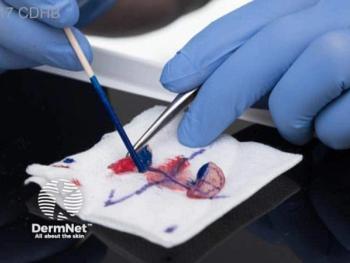
- Dermatology Times, December 2021 (Vol. 42. No. 12)
- Volume 42
- Issue 12
Applying GEP to Melanoma Detection
How can GEP be applied to melanoma diagnosis and treatment? Darrel Rigel, MD, MS, answers these questions and dives into the data at Fall Clinical Dermatology Conference 2021.
Genetic expression profiling (GEP) may become an important tool to aid melanoma diagnosis, according to Darrell Rigel, MD, MS, a clinical professor and director of the Melanoma Surveillance Clinic at the Icahn School of Medicine at Mount Sinai in New York, New York. He provided an overview of recent findings that demonstrated the accuracy of melanoma diagnosing at the 2021 Fall Clinical Dermatology Conference, held October 21 to 24 in Las Vegas, Nevada.1 During his presentation, he also explained the potential of the technique.
Rigel cited a 2017 study in which a noninvasive pigmented lesion assay (PLA) using a 2-GEP technique was evaluated in 555 pigmented lesions (157 training and 398 validation samples) obtained via adhesive patch biopsy.2 The technique searches for either a LINC or PRAME gene and determines melanoma from nonmelanoma samples with a 91% sensitivity and a specificity of 69%, with a 95% CI. The investigators concluded that GEP can classify pigmented lesions into melanoma and nonmelanoma groups and may be helpful with diagnostic challenges.
Newer research supports this claim, Rigel continued. In a 2021 trial, 90 dermatology clinicians tested 3418 lesions using 2-GEP. The median patient age was 48 years, with 62% female and 39% male patients. Of the total lesions, 324 (9.48%) were determined to be positive by 2-GEP testing—90.5% avoided unnecessary biopsy— and 316 were biopsied (97.5%), with 313 pathology reports available for analysis. Of the biopsied lesions, 18.7% were melanoma and 43% were dysplastic nevi, which was determined histopathologically.3
Of the melanomas and dysplastic nevi:
- 134 of 195 (61.7%) expressed a single gene (L+/P- or L-/P+)
- 61 of 195 (31.3%) expressed both genes (L+/P+)
When focusing solely on the melanomas, it was found:
- 31 of 59 (52.5%) confirmed melanomas expressed a single gene (L+/P- or L-/P+)
- 14 of 59 (23.7%) expressed LINC only (L+/P-)
- 17 of 59 (28.8%) expressed PRAME only (L-/P+)
- 28 of 59 (47.5%) confirmed melanomas expressed both genes (L+/P+)
Rigel quoted the study authors: “Lesions clinically suspicious of melanoma exist along a spectrum of genomic atypia,” they wrote. “There is a correlation between increasing genomic atypia and melanoma-associated pathology atypia.”
In addition, Rigel detailed a trial in which GEP was shown to increase both the real-world negative predictive value (NPV) and positive predictive value (PPV) of the melanoma diagnostic pathway and reduced biopsy burden.
In another study, researchers investigated 2-GEP–negative pigmented lesions (1233 total) for evidence of malignancy for up to 36 months and retested a separate prospective cohort of 2-GEP– negative lesions (302) up to 2 years after initial test- ing. The results demonstrated that in this real- world intended-use population, the 2-GEP has an NPV of greater than 99%, confirming the high NPV established in previous clinical studies.4
A PPV of 18.7% was determined by using a US-based registry of 2-GEP–tested cases (3418), identifying the melanoma diagnoses based on the 2-GEP–positive lesions. Of the 5993 lesions tested in the TRUST study and registry cases, most 2-GEP tests results were negative and not subjected to surgical biopsy. The 2-GEP test reduced surgical biopsies by 83.5% to 86.5% in the TRUST study and US registry cohorts, respectively.
Rigel went on to describe the DermTech PLA kit, which uses 2-GEP analysis. Following an initial appointment to assess the patient’s skin, the physician can order the PLA kit, which will be shipped directly to the patient. A follow-up appointment must be scheduled so the physician can supervise the patient, which can be done virtually. Finally, the laboratory analyzes the sample and reports the results to the physician.
A 3-GEP test (PLAplus) tests for a third gene, TERT. Rigel explained that TERT promoter mutations are detected in 70% of histopathologically confirmed melanomas, and 97% of histopathologically confirmed melanomas express TERT and/or LINC and/or PRAME.5,6
Mutations in the cell can lead to oncogenesis through functional increases in TERT protein, telomerase activity, telomere length, cell immortalization, and proliferation, according to Rigel. It is associated with histopathologic features of aggressiveness and poor survival in melanoma.
The 3-GEP data showed a 97% sensitivity with a 62% specificity, leading to a 99.6% NPV.
Rigel concluded the presentation with 3 points:
- Efficiency and accuracy are critical in MM diagnosis.
- Genomics is impacting this area.
- 2-GEP and 3-GEP testing can be a useful adjunct to this process in a clinical setting.
Disclosure:
Rigel is on the advisory board, honoraria, and investigator for Castle BioSciences. He is a consultant for DermTech.
References:
- Rigel, D. Apply GEP to melanoma detection. Presented at: Fall Clinical Dermatology Conference 2021; October 21-24, 2021; Las Vegas, Nevada and virtual.
- Gerami P, Yao Z, Polsky D, et al. Development and validation of a noninvasive 2-gene molecular assay for cutaneous melanoma. Journal of the American Academy of Dermatology. 2017;76(1):114-120.e2. doi:10.1016/j.jaad.2016.07.038
- Brouha B, Ferris L, Skelsey M, et al. Genomic atypia to enrich melanoma positivity in biopsied lesions: gene expression and pathology findings from a large u. S. Registry study. SKIN The Journal of Cutaneous Medicine. 2021;5(1):13-18. doi:10.25251/skin.5.1.3
- Skelsey M, Brouha B, Rock J, et al. Non-invasive detection of genomic atypia increases real-world npv and ppv of the melanoma diagnostic pathway and reduces biopsy burden. SKIN The Journal of Cutaneous Medicine. 2021;5(5):512-523. doi:10.25251/skin.5.5.9
- Cullison SRJ, Jansen B, Yao Z, Ferris LK. Risk stratification of severely dysplastic nevi by non-invasively obtained gene expression and mutation analyses. SKIN The Journal of Cutaneous Medicine. 2020;4(2):124-129. doi:10.25251/skin.4.2.5
- Ferris LK, Moy RL, Gerami P, et al. Noninvasive analysis of high-risk driver mutations and gene expression profiles in primary cutaneous melanoma. J Invest Dermatol. 2019;139(5):1127-1134. doi:10.1016/j.jid.2018.10.041
Articles in this issue
almost 4 years ago
Screening for Body Dysmorphic Disorderalmost 4 years ago
Clascoterone Cream First Topical to Target Androgen Receptorsalmost 4 years ago
2021's Breakthroughs & Disappointmentsalmost 4 years ago
Multimodal Plan Combats Combination Rosaceaalmost 4 years ago
Muscle Toning and Strengthalmost 4 years ago
Race, Ethnicity, Culture All Affect Hair Agingalmost 4 years ago
Work Smarter to Manage Occupational Dermatosesalmost 4 years ago
Do You Have the Right Financial Adviser?almost 4 years ago
6 Steps to Hiring Great Practice Staffalmost 4 years ago
Get the Facts on FlakingNewsletter
Like what you’re reading? Subscribe to Dermatology Times for weekly updates on therapies, innovations, and real-world practice tips.


















